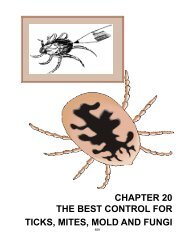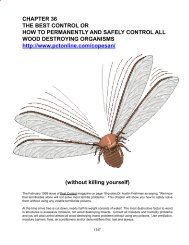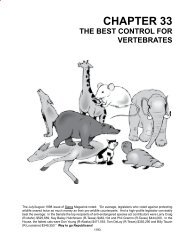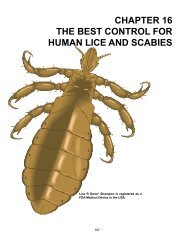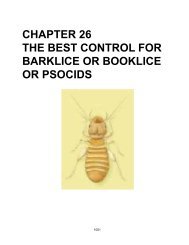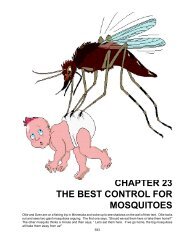American Beautyberry (Callicarpa americano) - <strong>The</strong> crushed leaves repel ticks, mosquitoes and other bitingbugs.American Cornflower - <strong>The</strong> roots of this plant contain an oil that repels and/or kills flies.American Plum (Prunus americana) - Leaves and flowers are toxic to insects.Ammonia - Can be used to control weeds in the Spring - later on it acts as a fertilizer. You can later killweeds with calcium nitrate or potash (4 cups per gallon of water) or 1 gallon of ammonia to 4 gallons of liquidurea with 2 oz. of a sticker. You can kill slugs with 1 part non-sudsing ammonia and 1 part water. Rags soakedin ammonia and dropped in gopher holes or rat holes etc., if you seal all of the openings - usually repels thepests in a hurry. Pour some in garbage cans to repel raccoons. Termites avoid anything that has ammonia/nitrogen on it. Many pests die when you spray them with ammonia. If you have no concrete or asphalt, you canuse ammonia to compact soil. That is why ground fertilized with ammonia can make the soil hard. Ammonianeutralizes the epoxide in mold. Never mix ammonia and chlorine bleach.Ammoniated Soap of Fatty Acids - Can be diluted and used as a weed and vegetation killer.Anise - People use anise to add a hint of licorice to everything from holiday cookies to robust bottles of ouzoand raki. Now Agricultural Research Service (ARS) has isolated 22 compounds in Pimpinella’s essential oilsand find high levels of organic mixtures called phenylpropanoids in anise Phenylpropanoids are found in a widevariety of plants, and some are thought to have health-boosting benefits. However, the chemical structure and thebiological activity of the Pimpinella phenylpropanoids are unique. Some phenylpropanoids the team found haveonly been found in Pimpinella and four of the compounds they isolated had never before been identified in anyplant. <strong>The</strong> compounds were evaluated for their activities against the plant fungus Collectotrichum, which causesanthracnose diseases worldwide. One unique compound was especially effective against strawberrysoft rot and leaf blight. In addition, Pimpinella isaurica essential oils were more effective in controllingaphids than isolated Pimpinella phenylpropanoids. <strong>The</strong>se compounds were also tested for theiractivity against various major and minor microbes. A few showed some effectiveness againstPlasmodium falciparum, the parasite that causes malaria in humans, and Mycobacterium intracellularaea bacterium that can cause illness in immunocompromised patients. Some phenylpropanoids exhibited antiinflammatoryactivities. Pimpinella essential oils also showed estrogenic effects in a yeast model and wereconsidered to have phytoestrogen properties. <strong>The</strong>se results suggest that Pimpinella essential oils may be a sourceof potent compounds that could be used in developing powerful new pharmaceuticals and agrochemical agents.Anise Oil - Repels dogs and cats and will kill spider mites and aphids.Annual Tillage - is probably the most important weed management practice.Ant Lions - <strong>The</strong>y resemble damsel flies but they have longer and blunter antennae; they are weak fliers. Adultsand larvae eat ants, ticks, small insects.Antibiosis - Some plants, e.g., garlic and marigolds, produce volatile oils, known as phytoalexins, that canrepel, injure or even kill pests, e.g., insects and/or fungi. Some plants even react by killing the tissue around thearea of the infestation, as well as killing the pathogen. Some plants encase repellents in vacuoles (little cellularpackages) that rupture when the insect or animal bites into the plant.Antibiotic - All antibiotics come from the soil and are substances produced by some microorganisms that inhibitother microorganisms; used properly they save lives. Used too often they create super bugs and resistant species.Antibiotics - e.g., Flagyl ® , tetracyclene, etc. Even 250 ml. soaked into cardboard as a bait station will kill anentire colony of termites in days in days by destroying the microflora and/or bacteria in their guts. Flagyl alsokills the protozoa in their guts. <strong>The</strong>re are several natural antibiotics in this chapter, e.g., goldenseal.Ants - In 324 B.C.E. the Chinese introduced ants (Acephali armaragina) to their citrus groves to control caterpillarsand large boring beetles. If you follow ants up the tree, you will find the aphids, scale and/or disease.356
Aphid Lions - See green lacewings.Aphid Midges - are tiny, bright orange maggots feed on more than 60 species of aphids. <strong>The</strong> adults aremosquito-like flies with long legs and delicate bodies. <strong>The</strong> adults lay eggs at night.Aphidiid Wasps - are tiny black wasps with long antennae. <strong>The</strong>y have only one specific host. <strong>The</strong>y lay theireggs in aphids were the larvae hatch and consume the aphid host.Aphytis melinus (Armored Scale Parasite) - is a small yellow wasp which will control scale insects, especiallyin citrus groves.Apple Cider Vinegar - Mix 3 tablespoons of natural apple cider vinegar to a gallon of water - spray during the coolpart of the day for black spot on roses and other fungal diseases - or try baking soda as another safe fungicidealternative or fungisafe. Boil to purify the air and control airborne bacteria, etc. To relieve arthritis symptoms,drink a glass of water with 2 teaspoons of apple cider vinegar and 2 teaspoons of unprocessed honey; do this3 times a day for at least 3 - 4 weeks to alleviate arthritis symptoms. You can also soak in warm, diluted applecider vinegar to hasten the results. Garlic supplements will also help. Mix straight apple cider vinegar andbaking soda to help cure insect bites and stings. Want to kill ringworm? Soak a rag or paper towel with applecider vinegar and cover the ringworm for 15 minutes several times a day.Apples - An apple a day is particularly good for your lungs. Organic applies are more effective than other fruitsand vegetables in reducing the risk of serious diseases, including lung cancer and chronic obstructive pulmonarydisease (COPD).Aromatic Cedar - Cedar wood, its shavings and/or mulch or oil made from the eastern red cedar or aromaticcedar tree, Juniperus virginiana (L), has long been known to possess pesticidal or repellant properties. Allstages of clothes moths and the black carpet beetle can be controlled with cedarwood or its oil or shavings.German cockroaches are repelled, but not killed by aromatic cedar. Ants do not like aromatic cedar mulchesand Argentine ants are killed for at least 4 months.Aromatic Plants - like garlic, chilies, mint, common rue and/or lavender will repel ants and many other pests -plant them in “troubled areas” and by entrances.Arrestants - are chemicals or pheromones used to bring about aggregations of insects and/or animals.Artemisia tridentata Nutt. ssp. Vaseyana (Rydb.) Beetle - <strong>The</strong> volatile fraction from mountain big sagebrushis an effective fumigant. <strong>The</strong> main component of the volatile fraction is 1,8-cineole.Asparagus (Asparagus officianalis var. altilis) - This plant has root exudates that reduce plant-parasiticnematodes in the soil. Plain asparagus juice will kill virtually all nematodes.Aspartame - contains about 40% neurotoxic aspartic acid. Aspartame is a very powerful ant and mouse killer.Carpenter ants and mice will eat the powdered aspartame, but small black ants are best controlled when you mixthe aspartame in apple juice and/or honey. To control fire ants, sprinkle aspartame on the mound; then slightlymoisten the powder with water. Try it in juice to control yellow jackets. When handling any toxin protect yourskin and keep it out of your mouth. Aspartame is 10% methanol; when ingested or at any temperature over 86 oF. it converts to formaldehyde and then formic acid - the same substance used to strip epoxy urethane coatings.(Formic acid causes metabolic acidosis.) Formic acid is the poison found in the sting of fire ants. <strong>The</strong> methanoltoxicity mimics health problems, e.g., multiple sclerosis and systemic lupus. <strong>The</strong> other 90% of aspartame iscomprised of phenylalanine and aspartic acid, amino acids which, when seperated from the other aminio acidsin you body, can become neurotoxic. In the 1970s FDA refused to approve aspartame for human consumptiondue to studies linking it to brain tumors, nuerological disorders and even death in laboratory animals. Stringswere pulled by powerful men like Donald Rumsfield and aspartame was approved by the FDA without furtherado. If you are using aspartame (NutraSweet, Equal, Spoonful, etc.) and you suffer from fibromyalgia symptoms,spasms, shooting pains, numbness in your legs, cramps, vertigo, dizziness, headaches, tinnitus, joint pain,unexplainable depression, anxiety attacks, slurred speech, blurred vision or memory loss…you probably haveaspartame poisoning. See Excitotoxins. See Equal ® or NutraSweet ® . Will kill ants and/or mice that eat a few357
- Page 1: CHAPTER 11SAFE AND FAR MOREEFFECTIV
- Page 4 and 5: pesticide poisons do - to them the
- Page 8 and 9: packets in 4 days or less. Aspartam
- Page 10 and 11: Baking Soda - Baking soda or sodium
- Page 13 and 14: Bioderivatives - are substances whi
- Page 15 and 16: Bird feeders - will attract more th
- Page 17 and 18: an abrasive action on the insect wh
- Page 19 and 20: pathogens - volatiles produced duri
- Page 21 and 22: ground, grain and stored product ap
- Page 23 and 24: epels many insects, including flies
- Page 25 and 26: een used medically since at least t
- Page 27 and 28: Collateral Damage - When you spray
- Page 29 and 30: Cottonseed Meal - is a source of ni
- Page 31 and 32: Desiccants - Hot air, dehumidifiers
- Page 33 and 34: Dogs - have been trained to sniff o
- Page 35 and 36: elderberry leaves to protect them f
- Page 37 and 38: controls pests and acts as a deodor
- Page 39 and 40: contamination that no one can hones
- Page 41 and 42: Chlorphyll Graphite Parrafin wax Wa
- Page 43 and 44: Film Capsule - The plastic capsule
- Page 45 and 46: Repel roaches with bay leaves and e
- Page 47 and 48: person in your house, but you’ll
- Page 49 and 50: slender sickle-shaped jaws. They ap
- Page 51 and 52: epellent that contains only natural
- Page 53 and 54: infusion of pignut leaves, rubbed o
- Page 55 and 56: Human Hair - cut in small pieces wi
- Page 57 and 58:
Insect Diseases - In 1836, Agostino
- Page 59 and 60:
Irrigation Management - Improper ir
- Page 61 and 62:
lack cutworms.Laxatives - Chocolate
- Page 63 and 64:
we die. Check out magnesium in Chap
- Page 65 and 66:
Milk Thistle - is a proven detoxifi
- Page 67 and 68:
Moon Flower (Datura ioxia) - Do not
- Page 69 and 70:
Spotted knapweed begins producing c
- Page 71 and 72:
Nothing - Doing nothing is a choice
- Page 73 and 74:
fertilizers and sprays will normall
- Page 75 and 76:
added to enzyme cleaners or when us
- Page 77 and 78:
yellow to yellow crystalline solid
- Page 79 and 80:
Aureolaria virginica (L.) Pennell.
- Page 81 and 82:
Clematis vitalba L. (Honduras fish
- Page 83 and 84:
Euphorbia bicolor Engelm. and Gray.
- Page 85 and 86:
Justicia adhatoda L. (Adhatoda vasi
- Page 87 and 88:
Momordica charantis L. (Balsam-pear
- Page 89 and 90:
Piper nigrum L. (Black pepper).Stro
- Page 91 and 92:
Sesamum indicum L. (S. orientale L.
- Page 93 and 94:
Xanthorrhoea hastilis R. Br. (Black
- Page 95 and 96:
Pomander - Repel moths and other in
- Page 97 and 98:
y Safe Solutions at 1-888-443-8738
- Page 99 and 100:
ight red and cover them with petrol
- Page 101 and 102:
a wide variety of antioxidants call
- Page 103 and 104:
Sawdust - Sawdust can be treated wi
- Page 105 and 106:
lit charcoal in the tunnels would a
- Page 107 and 108:
Active IngredientGeneric Name Trade
- Page 109 and 110:
Sour Milk - sprays will loosen scal
- Page 111 and 112:
Stay Calm - Take a deep breath amd
- Page 113 and 114:
to make the mix about the consisten
- Page 115 and 116:
pesticides have never controlled or
- Page 117:
Temperature - Increase or lower tem
- Page 120 and 121:
in colder climates. The most fragra
- Page 122 and 123:
and/or dehumidifiers, plumbing and
- Page 124 and 125:
odents, scorpions, etc. to your bai
- Page 126 and 127:
Oregano also contains four anti-ast
- Page 128 and 129:
like colds, and headaches and spend
- Page 130 and 131:
then estimated human population. Gi
- Page 132 and 133:
“The choice, after all, is ours t
- Page 134:
484



